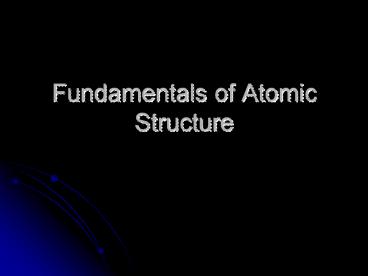Fundamentals of Atomic Structure - PowerPoint PPT Presentation
1 / 17
Title: Fundamentals of Atomic Structure
1
Fundamentals of Atomic Structure
2
Fundamental Chemical Laws
- Law of Conservation of Mass-mass is neither
created or destroyed (Lavoisier) - Law of Definite Proportions-a given compound
always contains exactly the same proportion of
elements by mass (Proust) - Law of Multiple Proportions-when two elements
from a series of compounds, the ratios of the
masses of the second element that combine with 1
gram of the first element can always be reduced
to small whole numbers (Dalton) - (See sample exercise 2.1 on page 42)
3
Daltons Atomic Theory
- Each element is made up of tiny particles called
atoms. - The atoms of a given element are identical the
atoms of different elements are different in some
fundamental way. - Chemical compounds are formed when atoms of
different elements combine with each other. A
given compound always has the same relative
numbers and types of atoms. - Chemical reactions involve reorganization of the
atoms-changes in the way they are bound together.
The atoms themselves are not changed in a
chemical reaction.
4
Subatomic Particles
- The electron was discovered by J.J. Thomson
through his study of the cathode-ray tube. - His studies also resulted in the determination of
the charge-to-mass ratio of an electron. - e/m -1.76 x 108 C/g
- A new atomic model was developed called the plum
pudding model. - In 1909, Robert Millikan performed an experiment
using charged oil drops which allowed him to
determine the magnitude of the electrons charge
(1.60 x 10-19 C). - This led directly to the determination of the
mass of an electron (9.11 x 10-31 kg).
5
The Nuclear Atom
- Rutherfords Gold Foil experiment resulted in the
determination that the atom is mostly empty space
with a small, dense, positively charged center
(nucleus). - The electrons move around the nucleus at a
distance that is large relative to the nuclear
radius. - This model of the atom is also referred to as the
planetary model.
6
Discovery of the Proton and Neutron
- A positively charged particle equal in magnitude
to the electron was discovered by Goldstein.
This particle is 1837 times larger in mass than
the electron (1.67 x 10-27 kg) and is called a
proton. - Chadwick, in 1932, discovered the existence of a
particle having no charge and almost equal in
mass to the proton. (1.67 x 10-27 kg) This
particles is called the neutron. - See page 50 for a comparison of three subatomic
particles.
7
Representing Atomic Structure
- The atomic number (Z) is equal to the number of
protons. - Since atoms are neutral, the number of protons
equals the number of electrons. - The mass number (A) is equal to the number of
protons and neutrons. (This number is
approximately equal to the mass of the atom). - The number of neutrons can be determined by
subtracting the atomic number from the mass
number. - Isotopes are atoms of the same element that have
different masses due to differing numbers of
neutrons.
8
Ions
- An atom that gains electrons forms a negative ion
called an anion. - An atom that loses electrons forms a positive ion
called a cation.
9
Find the average score for the following sets of
AP Chemistry data
- Buford High School data 4 students scored a 5
- (22 students total) 11 students
scored a 4 - 4
students scored a 3 - 3
student scored a 2 - 0
students scored a 1 - Global data 15.5 scored a 5
- (122,000 students total) 19.2 scored a 4
- 20.2 scored a 3
- 15.2 scored a 2
- 30.0 scored a 1
10
Atomic Mass Determination
- The atomic masses listed on the periodic table
represent the average mass of the isotopes
composing a sample of the element. - To determine the average atomic mass, the mass of
the isotope and the percent abundance must be
known.
11
Solve the following problem
- An element consists of 1.40 of an isotope with
mass 203.973 amu, 24.10 of an isotope with mass
205.9745 amu, 22.10 of an isotope with mass
206.9759 amu, and 52.40 of an isotope with mass
207.9766 amu. Calculate the average atomic mass
and identify the element.
12
Atomic Mass
- The most accurate method for determining masses
of atoms involves the use of a spectrometer. - The atomic masses listed on the periodic table
represent the average mass of the isotopes
composing a sample of the element. - To determine the average atomic mass, the mass of
the isotope and the percent abundance must be
known.
13
Introduction to the Periodic Table
- The periodic table is organized by increasing
atomic number. - Horizontal rows are called periods.
- Vertical columns are called groups.
- Elements within the same group have similar
chemical properties.
14
Organization of the Periodic Table
- Metals are found on the left side of the table
and share the following properties - 1) tend to be solids at room temperature
- 2) have luster
- 3) malleable and ductile
- 4) react with acids
- 5) conduct heat and electricity
- 6) lose electrons and form positive ions
15
Organization of the Periodic Table
- Nonmetals are found on the upper right side of
the table and share the following properties - 1) tend to be liquids and gases at room
temperature - 2) are dull
- 3) are brittle
- 4) are nonconductors
- 5) dont react with acids
- 6) gain electrons and form negative ions.
16
Organization of the Periodic Table
- Metalloids are elements that have properties of
both metals and nonmetals. - Metalloids are located along the diagonal line
dividing the metals from the nonmetals.
17
Organization of the Periodic Table
- Group 1A alkali metals
- Group 2A alkaline earth metals
- Group 7A halogens
- Group 8A noble gases































